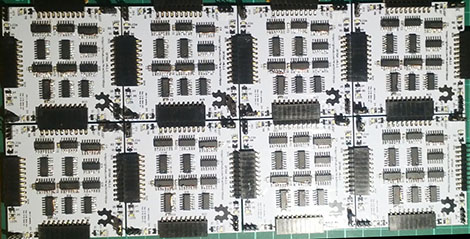Discrete FPGA will probably win the 7400 logic competition:
For this year’s 7400 logic competition, [Nick] decided to build an FPGA out of logic chips.
Perhaps a short explanation is in order to fully appreciate [Nick]‘s work. The basic component of an FPGA is a slice, or cell, that performs boolean operations on its input and sends the result on its output. The core of these slices is a lookup table – basically a truth table that stores the result of every possible input combination.
One very easy way to implement a lookup table is to use a RAM or EEPROM chip. By tying the address lines of an EEPROM to the input and the data lines to the output, it’s possible to create a single slice of an FPGA very easily.
Unfortunately for [Nick], 74-series memories have long been out of production. There is another option open, though: shift registers. A shift register is basically an 8-bit memory chip with parallel inputs, so combining a shift register with an 8-input multiplexer is a very simple way to implement a 3-input, 1-output FPGA slice.
After figuring out how to tie these slices to bus lines, [Nick] needed a way to program them. Verilog or VHDL would border on insanity, so he wrote his own hardware description language. It’s certainly not as powerful or capable as the mainstream solutions to programming an FPGA, but it’s more than enough.
In the video after the break, you can see [Nick]‘s overview of his very large 8-slice FPGA while he runs a combination lock and PWM program. All the code, schematics, and board layout are up on [Nick]‘s git if you’d like to build your own.
Filed under: hardware
News about linux, computer, computer science, mathematics and white hot chocolate, the most beautiful drink in this world.
Saturday, November 3, 2012
Discrete FPGA will probably win the 7400 logic competition
This is a mega hack!
Subscribe to:
Post Comments (Atom)

No comments:
Post a Comment